Overview
We recognize that successful digital transformation in healthcare is not just a goal—it’s a necessity for 2022. Our article outlines seven essential steps to guide you through this critical journey, emphasizing the importance of stakeholder engagement, technology integration, and continuous monitoring. By conducting a thorough SWOT analysis, implementing pilot programs, and adapting strategies based on performance metrics, we can enhance patient care and operational efficiency. These steps are not merely recommendations; they are vital to navigating the complexities of today’s healthcare landscape.
What’s holding your team back from embracing these changes? Let’s work together to transform challenges into opportunities for growth and success.
Introduction
In the rapidly evolving landscape of healthcare, we recognize that digital transformation stands as a crucial pathway for enhancing patient care and operational efficiency. As we navigate the complexities of integrating advanced technologies, a comprehensive assessment of our current capabilities becomes essential.
By conducting a thorough SWOT analysis, we can identify our strengths and weaknesses while uncovering opportunities for growth through innovations like telehealth and AI. However, this journey is fraught with challenges, including cybersecurity threats and compliance issues.
Engaging stakeholders and fostering a culture of innovation are vital components for our success, ensuring that our digital initiatives align with user needs and expectations. This article delves into the multifaceted strategies necessary for effective digital transformation in healthcare, from identifying key technologies to monitoring progress and adapting strategies for continuous improvement.
Assess Current Digital Transformation Landscape in Healthcare
To effectively assess the current digital transformation in healthcare 2022 landscape, we must conduct a SWOT analysis of existing digital capabilities. This analysis will identify strengths, such as robust data management systems and creative participant engagement tools, while also recognizing weaknesses, including outdated legacy systems and integration challenges. Opportunities for growth may arise from emerging technologies like telehealth and AI-driven analytics, which are pivotal to the digital transformation in healthcare 2022, showing promise in humanizing patient care through personalized treatment options and enhanced engagement. However, threats could stem from cybersecurity risks and regulatory compliance issues.
Gathering feedback from stakeholders—including healthcare providers, IT staff, and patients—is crucial for understanding their experiences and expectations. This feedback can reveal gaps in service delivery and emphasize areas for enhancement, ensuring that our initiatives align with user requirements. For example, the combination of AI and VR technologies can offer more comprehensive user interactions, as demonstrated with AI avatars such as SimCoach that help individuals grasp their treatment options, thus improving the overall user experience.
A comprehensive evaluation of current online tools and platforms is essential to determine their effectiveness and integration potential. This assessment should take into account how effectively these tools facilitate clinical workflows and improve care for individuals, as well as their capability to interoperate with other systems. The progress in electronic healthcare, exemplified by the digital transformation in healthcare 2022 through virtual reality tools that diminish pain awareness during medical procedures, illustrates how technology can transform individual experiences. Evaluating individual data and outcomes is another essential step. By recognizing trends and areas where technological advancement could improve care delivery, we can prioritize initiatives that support digital transformation in healthcare 2022, leading to better health outcomes and operational efficiencies. The significance of data accessibility cannot be exaggerated; enabling patients to manage their health information is crucial for investigating new treatment possibilities and enhancing care.
Statistics show that only 44% of leaders feel equipped to address the disruptions caused by technological change, highlighting a considerable gap in preparedness. Moreover, 44% of organizations express concern about forming a dedicated team to lead change initiatives. These insights emphasize the significance of strategic planning and stakeholder involvement in managing the complexities of digital transformation in healthcare 2022, as highlighted by key participants in the market such as Cerner Corporation, Apple, Epic Systems Corporation, Huawei, Cisco, and Philips Healthcare. Avato’s committed hybrid integration platform can serve a crucial function in streamlining these distinct systems, allowing us to concentrate on delivering high-quality care.
Case studies, such as the global perspectives on electronic health adoption, highlight the necessity for customized strategies that take into account economic, cultural, and regulatory variations across regions. Comparative analyses can enhance methods for incorporating sustainability and technological advancement, ensuring that medical systems globally are prepared to tackle future challenges efficiently.
Identify Key Technologies for Digital Transformation
We must conduct thorough research on critical technologies such as Electronic Health Records (EHR), telemedicine platforms, and AI-driven diagnostic tools. These technologies are crucial in streamlining healthcare operations and enhancing outcomes for individuals. By evaluating the integration capabilities of these technologies with existing systems, we can facilitate seamless data flow. Effective integration is essential for maximizing the potential of our digital transformation initiatives. Our dedicated hybrid integration platform excels in this area, simplifying complex integrations and enhancing business value by unlocking isolated assets and enabling seamless data connectivity.
We prioritize technologies that enhance user engagement, including mobile health applications and client portals. These instruments empower individuals and elevate their overall experience within the medical system. Furthermore, we stay informed about emerging trends, such as the use of blockchain for improved data security and the Internet of Things (IoT) for remote health monitoring. These innovations are poised to transform healthcare delivery and management. The AMA has expressed excitement regarding upcoming technology innovations that aid healthcare, underscoring the significance of these advancements.
Consider the successful implementations of telemedicine platforms in hospitals, which have demonstrated significant improvements in patient access and care continuity. We examine case studies on EHR integration in the medical field, particularly the one titled ‘Outsourcing Digital Transformation in Healthcare 2022,’ which highlights the advantages of collaborating with skilled partners for organizations lacking internal IT knowledge. This method can enhance the efficiency and effectiveness of electronic medical change efforts.
Additionally, we analyze EHR adoption rates and integration capabilities with telemedicine platforms, as these metrics are essential for grasping the current landscape and future potential of electronic health solutions. Moreover, the groundbreaking influence of 3D printing technology in producing prosthetics and custom implants is a significant element of the digital transformation in healthcare 2022.
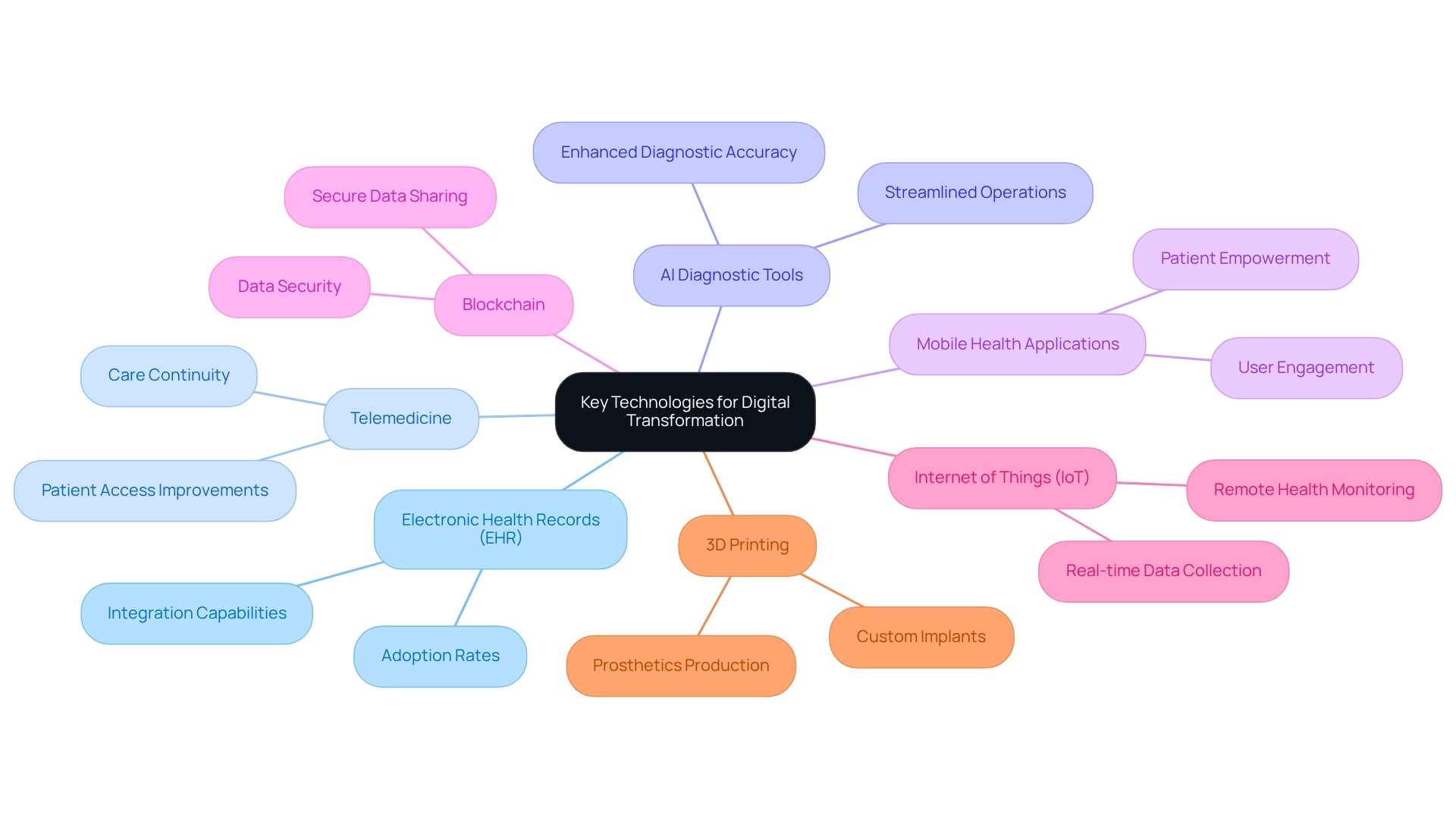
Ensure Compliance and Security in Digital Initiatives
Ensure Compliance and Security in Digital Initiatives.
We recognize that to successfully implement Avato’s hybrid integration platform, investing in comprehensive training programs is essential. Our staff must be equipped with the necessary skills and knowledge regarding data privacy and security best practices. This training is not just beneficial; it is crucial, especially considering that a significant percentage of healthcare data breaches are linked to lost devices. This highlights the urgent need for vigilant device management and robust security protocols.
Furthermore, we understand that implementing effective change management strategies will facilitate a smoother transition and foster a culture of innovation within our organization. Establishing a comprehensive response plan for potential data breaches, including clear notification procedures and remediation strategies, is vital. By prioritizing these training and change management initiatives, we can significantly enhance our compliance and security stance in the online environment.
What steps will we take to ensure our organization is prepared for the challenges ahead?
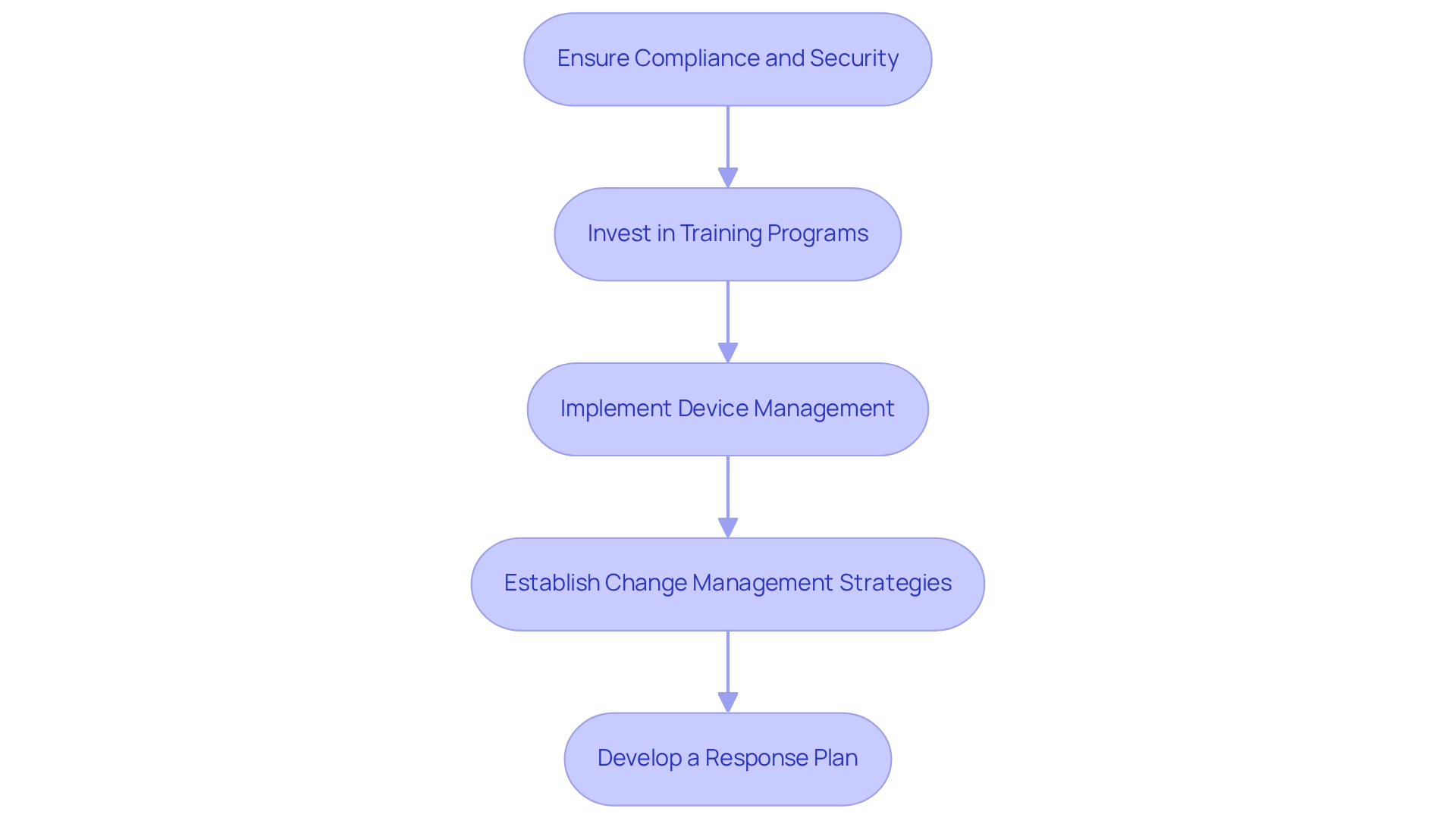
Develop a Comprehensive Digital Transformation Strategy
We must set clear aims and targets for our technology initiatives as part of the digital transformation in healthcare 2022, prioritizing patient results and operational effectiveness to foster significant change. Leveraging Avato’s hybrid integration platform streamlines this process by providing a connected foundation that simplifies and modernizes operations.
What key performance indicators (KPIs) will effectively measure our progress and success? It is essential to ensure alignment with our strategic objectives. With Avato’s platform, we can enhance operational visibility, allowing for better tracking of these KPIs. Involving a varied group of stakeholders across our organization is crucial to collecting valuable insights and encouraging dedication to the change strategy. Success resides in promoting cooperation among stakeholders, including policymakers, technology partners, and clinical staff, to establish a shared vision for electronic healthcare. Avato’s platform supports this collaboration by integrating isolated systems and fragmented data, facilitating seamless communication.
We need to develop a detailed implementation timeline that includes specific milestones and deadlines for each phase, facilitating accountability and tracking of progress. Disassembling the electronic change strategy into manageable elements guarantees success, especially when employing Avato’s organized requirements management features. Utilizing case studies, such as the effects of telehealth on accessibility for rural communities, demonstrates successful strategies and results in the context of digital transformation in healthcare 2022. The digital transformation in healthcare 2022 has changed medical accessibility, reducing obstacles to specialist care and minimizing travel needs, thereby enhancing access to services. Avato’s integration solutions can further enhance these outcomes by ensuring secure and reliable data sharing.
We should include expert perspectives on establishing achievable objectives and KPIs, highlighting the significance of cooperation among stakeholders to develop a cohesive vision for digital transformation in healthcare 2022 and promote digital wellness. Regularly reviewing and adjusting our strategy based on performance metrics and evolving industry trends is crucial. Avato’s platform allows for real-time access to data, enabling informed decision-making.
Furthermore, offering multilingual and accessible platforms is essential to accommodate users with disabilities or language barriers, further enhancing patient outcomes. Avato’s commitment to secure transactions and operational efficiency positions us as a key player in transforming business integration within the healthcare sector. To investigate how Avato can support your online advancement journey, contact us today and uncover the potential of our hybrid integration platform.
Engage Stakeholders and Foster a Culture of Innovation
We are committed to arranging workshops and training sessions that inform our staff about the advantages of technological change. It is crucial that all team members grasp the significance and impact of new innovations on individual care and operational effectiveness. By emphasizing dynamic interactions during these sessions, we can foster an agile culture within our medical organizations, similar to how Avato accelerates the integration of isolated systems and fragmented data, delivering the connected foundation enterprises need.
We will create cross-functional teams that bring together diverse perspectives from various departments, facilitating collaboration and enhancing the adoption of medical technologies. This approach not only improves communication but also aligns different stakeholders towards common goals, much like Avato’s support for 12 levels of interface maturity, balancing the speed of integration with the sophistication required to future-proof technology stacks.
We recognize and reward innovative ideas and contributions from our staff, fostering a culture of continuous improvement. By honoring achievements and promoting innovation, we inspire our employees to engage in the change process, reflecting the favorable responses from clients such as Tony LeBlanc of the Provincial Health Services Authority, who commended Avato’s expertise and professionalism.
Furthermore, we actively seek ongoing input from stakeholders, including medical professionals and individuals, to improve and advance our initiatives. Involving stakeholders ensures that the solutions we create are user-focused and adequately tackle real-world issues, akin to how electronic medicine is changing patient care through AI and VR technologies.
We utilize case studies that showcase successful workshops and training initiatives in medical technological advancement. Organizations applying agile leadership principles have experienced enhanced stakeholder alignment and cooperation, which are essential for managing the intricacies of technological change. An illustrative instance is how agile leadership enabled teamwork among medical teams, resulting in more efficient execution of technological solutions.
Moreover, we emphasize the urgency of involving stakeholders by utilizing statistics; for instance, 68 percent of organizations indicated that the pandemic hastened their technological advancement efforts significantly. This statistic illustrates the pressing need for medical organizations to adapt quickly and effectively, particularly through stakeholder engagement, which Avato’s solutions can support by ensuring secure transactions and enhancing data accessibility as part of the digital transformation in healthcare 2022.
Finally, we foster a culture of innovation by integrating expert opinions on the importance of stakeholder engagement in the digital transformation in healthcare 2022. Involving stakeholders increases the chances of successful execution and fosters a setting where innovation can flourish, ultimately resulting in enhanced outcomes for individuals and operational efficiencies.
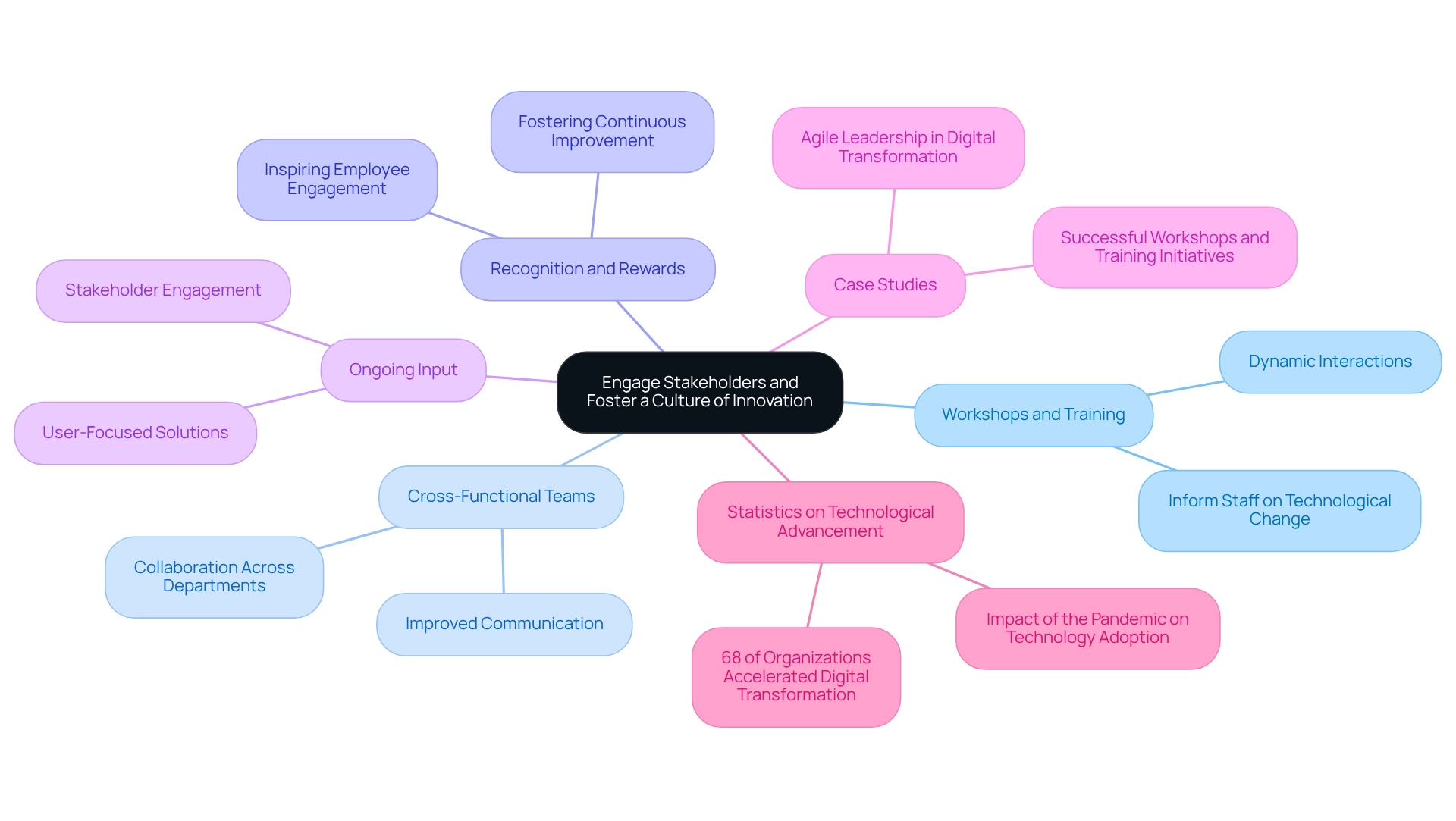
Implement Pilot Programs to Test New Technologies
We must identify a specific department or service line to initiate a pilot program for new technology, ensuring alignment with our organizational goals and user needs. Investing in comprehensive training programs is essential to ensure our staff is comfortable with Avato’s hybrid integration platform. Additionally, implementing change management strategies will smooth the transition and foster a culture of innovation within our organization. We should establish clear objectives and success metrics, such as predefined key performance indicators (KPIs), to evaluate the pilot’s effectiveness. By measuring the success of a pilot program against these predefined objectives, we can achieve measurable outcomes that guide our future decisions.
Throughout the pilot phase and after its conclusion, we must actively gather feedback from users. This feedback is crucial for identifying strengths and weaknesses, enabling continuous improvement of the technology. Analyzing the insights gained from the pilot will allow us to refine the technology and develop a comprehensive plan for broader implementation. This iterative process not only enhances the technology but also increases user buy-in for future rollouts.
Quantifying potential savings from early issue identification during the pilot can provide a compelling return on investment (ROI) figure, reinforcing the value of conducting pilot programs before full-scale launches. This analysis is essential for justifying our investment in new technologies, as highlighted in the case study “Quantifying ROI from Pilot Programs.”
We can utilize case studies that showcase successful pilot programs in the medical field to demonstrate best practices and outcomes. For instance, organizations that have effectively implemented pilot programs have reported significant improvements in operational efficiency and patient care. As Gustavo Estrada noted, “Avato has simplified complex projects and delivered results within desired time frames and budget constraints,” showcasing the effectiveness of pilot programs.
As the medical landscape evolves in 2025, staying informed about emerging trends and technologies will be essential. Implementing pilot programs not only aids the adoption of innovative solutions but also positions us in medicine, including those in banking, to adjust to future challenges and opportunities. Furthermore, ensuring that our choice of hybrid trial design is justified and reported clearly will enhance the credibility and effectiveness of the pilot program.
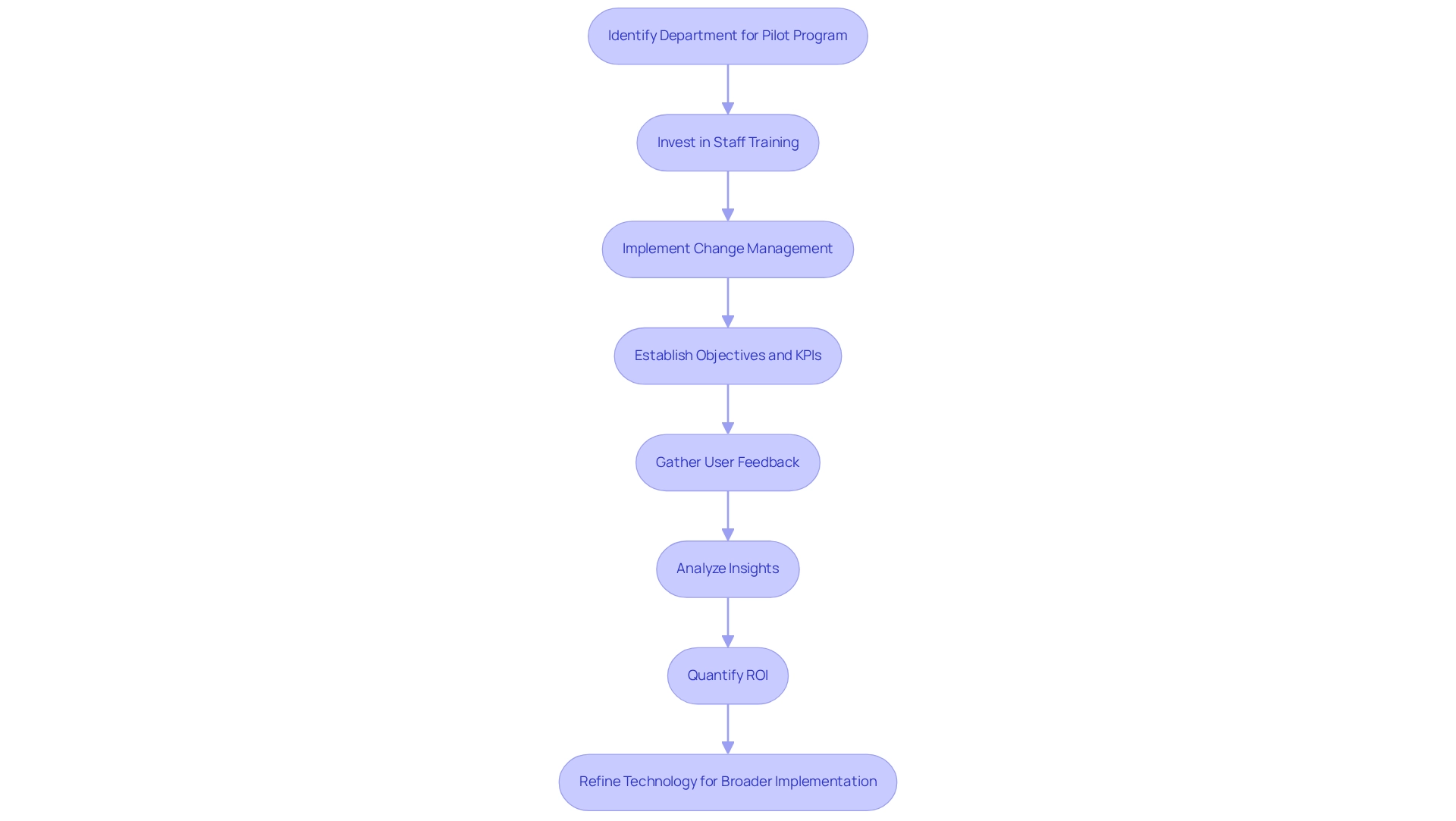
Monitor Progress and Adapt Strategies as Needed
We consistently assess KPIs and performance metrics to gauge the success of our technological change initiatives. This practice is crucial, as it allows us to align our efforts with broader operational goals and ensure tangible improvements.
We conduct periodic stakeholder meetings to discuss progress, challenges, and opportunities for enhancement. Engaging stakeholders fosters collaboration and ensures that all voices are heard, which is vital for navigating the complexities of digital transformation.
Furthermore, we are prepared to pivot strategies based on feedback and evolving market conditions. The medical environment is ever-changing, and adaptability in strategy can result in more efficient solutions that satisfy the requirements of both providers and individuals.
We celebrate successes and share lessons learned to cultivate a culture of continuous improvement. Recognizing achievements not only boosts morale but also reinforces the importance of innovation in enhancing patient care and operational efficiency.
With almost 60% of healthcare providers indicating quicker appointment bookings due to technological tools, the effectiveness of scheduling illustrates the beneficial effect of technological transformation on key performance indicators (KPIs). This statistic emphasizes the importance of tracking progress to ensure that our technological initiatives are producing the desired outcomes. Moreover, Avato’s hybrid integration platform guarantees 24/7 availability for essential integrations, supporting these technological tools and boosting operational efficiency while facilitating seamless data access.
As online burnout becomes a concern—stemming from overloaded dashboards and alert fatigue—we find it essential to streamline processes and minimize unnecessary complexity. Our solutions are designed to address these challenges, focusing on user experience to significantly enhance patient care and operational efficiency. As Rituparna, a tech writer, notes, “The way businesses operate has changed. At the heart of this change is cloud technology,” underscoring the need for effective digital transformation strategies that we provide.
Insights from process automation tracking can ensure that our initiatives align with broader goals and deliver tangible improvements, reinforcing the importance of regular KPI reviews.
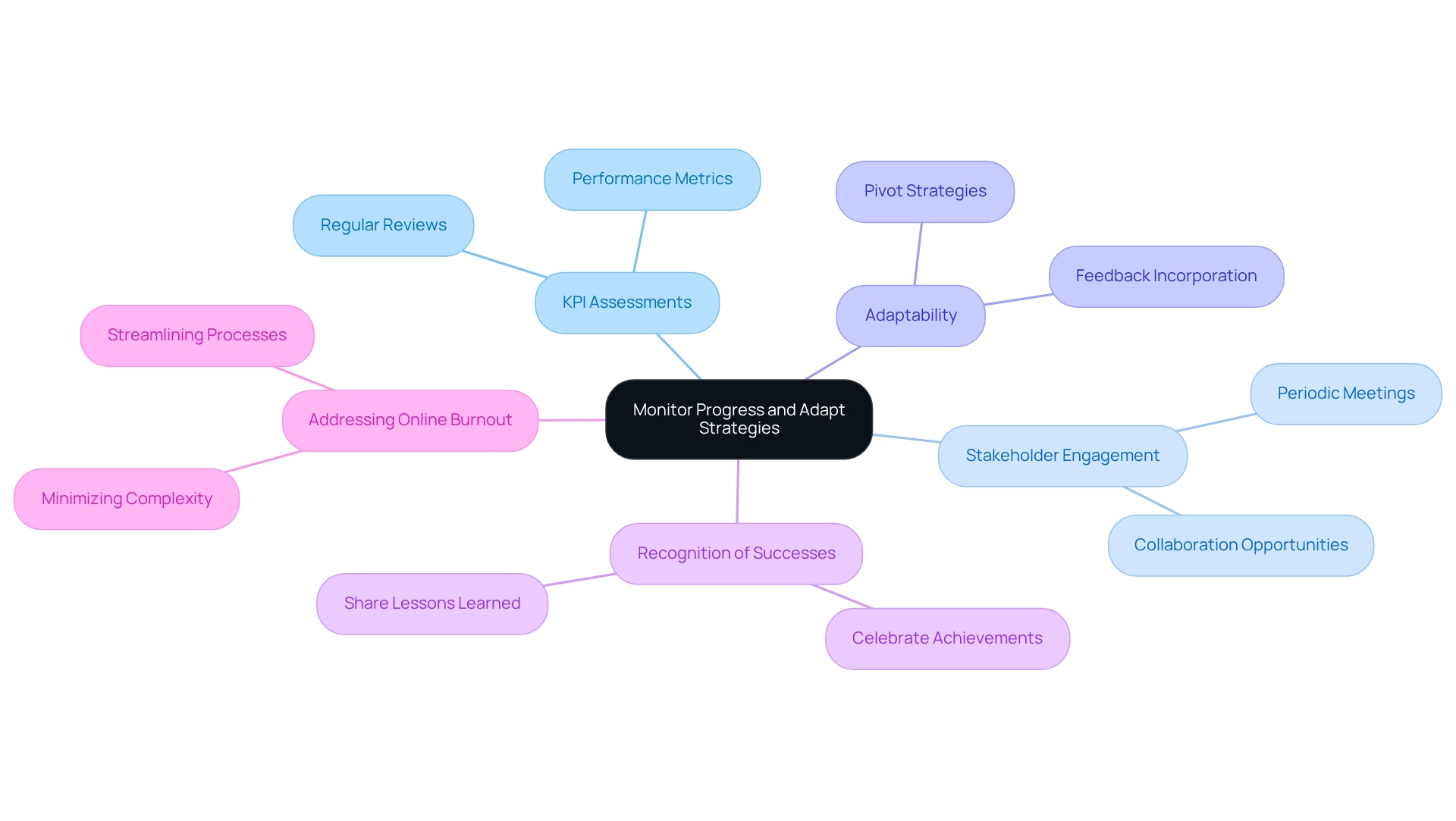
Conclusion
Digital transformation in healthcare is not merely a trend; it is a vital necessity for enhancing patient care and operational efficiency. As we conduct a thorough SWOT analysis, we uncover the strengths, weaknesses, opportunities, and threats that organizations encounter on this journey. By embracing technologies such as telehealth and AI, we can enhance patient engagement and streamline operations. However, this transformation must be approached with caution, as challenges like cybersecurity risks and compliance issues present significant hurdles.
Engaging stakeholders is crucial to ensure that our digital initiatives align with user needs. By fostering a culture of innovation through training and collaboration, we can navigate the complexities of this transformation. Implementing pilot programs allows us to test new technologies in a controlled manner, providing valuable insights that guide broader adoption. Regular monitoring of progress through KPIs and stakeholder feedback ensures that our strategies remain adaptable and effective.
Ultimately, the successful integration of digital technologies in healthcare hinges on strategic planning, stakeholder engagement, and a commitment to continuous improvement. By leveraging platforms that facilitate seamless data connectivity and operational efficiency, we can not only meet current challenges but also prepare for the future landscape of patient care. Embracing these changes will lead to enhanced patient outcomes, improved operational efficiencies, and a more resilient healthcare system overall.

